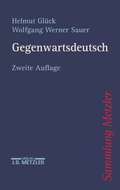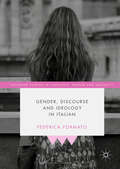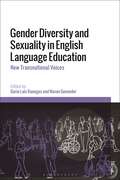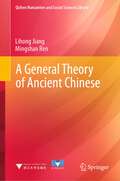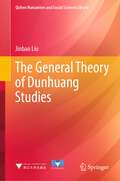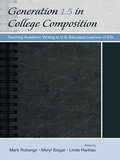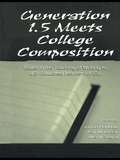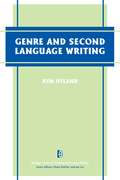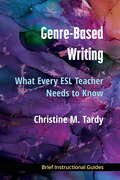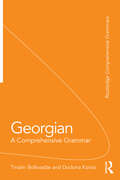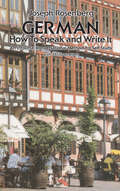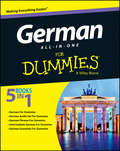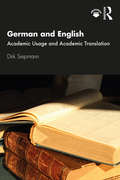- Table View
- List View
Gegenwartsdeutsch (Sammlung Metzler)
by Helmut Glück Wolfgang Werner SauerDer Band gibt einen anschaulichen, mit zahlreichen Wort- und Bildbeispielen versehenen Überblick über aktuelle Entwicklungen der deutschen Sprache. Die 2. Auflage berücksichtigt die Sprachentwicklung nach dem Ende der DDR und die viel diskutierte Rechtschreibreform.
Gender, Discourse and Ideology in Italian (Palgrave Studies in Language, Gender and Sexuality)
by Federica FormatoThis book analyses gendered language in Italian, shedding light on how the Italian language constructs and reproduces the social imbalance between women and men, and presenting indirect and direct instances of asymmetrical constructions of gender in public and private roles. The author examines linguistic treatments of women in politics and the media, as well as the gendered crime of femminicidio, i.e. the killing of women by their (former) partners. Through the combination of corpus linguistics, surveys, and discourse analysis, she establishes a new approach to the study of gendered Italian, a framework which can be applied to other languages and epistemological sites. This book will be of particular interest to students and scholars of sociolinguistics, language and gender, discourse analysis, Italian and other Romance languages.
Gender, Discourse and Ideology in Italian (Palgrave Studies in Language, Gender and Sexuality)
by Federica FormatoThis book analyses gendered language in Italian, shedding light on how the Italian language constructs and reproduces the social imbalance between women and men, and presenting indirect and direct instances of asymmetrical constructions of gender in public and private roles. The author examines linguistic treatments of women in politics and the media, as well as the gendered crime of femminicidio, i.e. the killing of women by their (former) partners. Through the combination of corpus linguistics, surveys, and discourse analysis, she establishes a new approach to the study of gendered Italian, a framework which can be applied to other languages and epistemological sites. This book will be of particular interest to students and scholars of sociolinguistics, language and gender, discourse analysis, Italian and other Romance languages.
Gender Diversity and Sexuality in English Language Education: New Transnational Voices
by Darío Luis Banegas and Navan GovenderThis book combines teaching-informed research studies and research-informed teaching accounts which explore English language education that engages with (a)gender and (a)sexual diversity. Informed by critical theories, critical literacy, post-structuralism, queer theory, and indigeneity/(de)coloniality, the critical perspectives in this volume consider gender and sexuality as dimensions of human life and aim to promote sexual, gender, emotional and relational wellbeing together with the construction of cultural horizons and citizenship. The chapters are organised around three interdependent areas of inquiry: 1) how educators design pedagogies and curriculums around gender diversity and sexuality, 2) how students and teachers navigate issues of gender diversity and sexuality in practice, as well as 3) how issues of gender diversity and sexuality are (not) addressed in the materials for teaching and learning English.The contributors are all teacher educators-researchers and therefore have vast experience in enacting, implementing, designing, and examining the field of English language teacher education from/for the classroom with a gender perspective in diverse settings, with chapters come from Argentina, Bangladesh, Canada, Germany, Norway, Poland, Saudi Arabia, South Africa, Spain, Taiwan, Turkey, the UK and Uruguay.
Gender Diversity and Sexuality in English Language Education: New Transnational Voices
This book combines teaching-informed research studies and research-informed teaching accounts which explore English language education that engages with (a)gender and (a)sexual diversity. Informed by critical theories, critical literacy, post-structuralism, queer theory, and indigeneity/(de)coloniality, the critical perspectives in this volume consider gender and sexuality as dimensions of human life and aim to promote sexual, gender, emotional and relational wellbeing together with the construction of cultural horizons and citizenship. The chapters are organised around three interdependent areas of inquiry: 1) how educators design pedagogies and curriculums around gender diversity and sexuality, 2) how students and teachers navigate issues of gender diversity and sexuality in practice, as well as 3) how issues of gender diversity and sexuality are (not) addressed in the materials for teaching and learning English.The contributors are all teacher educators-researchers and therefore have vast experience in enacting, implementing, designing, and examining the field of English language teacher education from/for the classroom with a gender perspective in diverse settings, with chapters come from Argentina, Bangladesh, Canada, Germany, Norway, Poland, Saudi Arabia, South Africa, Spain, Taiwan, Turkey, the UK and Uruguay.
Gender, Sprache, Kognition: Eine linguistische Untersuchung zu gender-inklusivem Sprachgebrauch im Spanischen (Linguistik in Empirie und Theorie/Empirical and Theoretical Linguistics)
by Miriam ZapfDie Debatte über gender-inklusiven Sprachgebrauch wird in der Wissenschaft wie in der Gesellschaft kontrovers geführt. Dabei werden kognitive Aspekte häufig vernachlässigt; dies gilt in besonderem Ausmaß für das Spanische, wo die Interpretation „generischer“ Maskulina und gender-inklusiver Formen der Personenbezeichnung aus psycholinguistischer Perspektive praktisch nicht erforscht ist. Die vorliegende Arbeit leistet einen wichtigen Beitrag, um diese Forschungslücke zu schließen und die eher theoretisch und z.T. ideologisch geprägte Debatte auf eine empirische Basis zu stellen. Mithilfe eines innovativen Versuchsaufbaus, der auch nicht-binäre Personenbezeichnungsformen berücksichtigt, untersucht sie, welche Assoziationen „generische“ Maskulina sowie alternative, gender-inklusive Formen hervorrufen. Dabei zeigt sich, dass „generische“ Maskulina oft mit einem male bias interpretiert werden, das in einigen Fällen durch gender-inklusive Formen reduziert oder beseitigt werden kann. Die Ergebnisse geben außerdem Hinweise auf eine Dynamik, die in der Forschung bislang kaum diskutiert wird: Womöglich gehen gerade eine zunehmende Thematisierung und Umsetzung gender-inklusiven Sprachgebrauchs damit einher, dass „generische“ Maskulina immer weniger generisch interpretiert werden, gender-inklusive Personenbezeichnungsformen hingegen immer stärker.
A General Theory of Ancient Chinese (Qizhen Humanities and Social Sciences Library)
by Lihong Jiang Mingshan RenThis book systematically outlines the development of ancient Chinese. Consisting of 20 chapters, the self-contained work presents macro-level discussions on a broad range of topics, including: philology, phonology, exegetics, certain words’ special meanings, sentence types, the flexible use of words, different grammars in ancient and modern times, and rhetoric. Though chiefly focusing on vocabulary, the book also addresses grammar, and points out grammar problems that differ considerably from those in modern Chinese, in addition to combining morphology and syntax. Further, unlike the majority of textbooks on the subject, it pays more attention to the rhetoric used in ancient Chinese literary works. Rather than simply analyzing linguistic phenomena, the book also (and more importantly) provides a meaningful approach to the study of ancient Chinese. Accordingly, it offers a valuable asset for researchers, graduate students, and everyone else who is interested in ancient Chinese.
The General Theory of Dunhuang Studies (Qizhen Humanities and Social Sciences Library)
by Jinbao LiuDunhuang studies refer to a discipline focusing on Dunhuang Manuscripts, Dunhuang grotto art, the theory of Dunhuang studies, and Dunhuang history and geography. It is a broad subject of studying, excavating, sorting, and protecting the cultural relics and documents in the Dunhuang area of China.The General Theory of Dunhuang Studies explores the basic concept of Dunhuang studies. It presents a more comprehensive and systematic study of six aspects of Dunhuang, covering the background of Dunhuang studies in orientalism, the history of Dunhuang, Dunhuang grotto art, the scattering of Dunhuang cultural relics, Dunhuang manuscripts, and the history of Dunhuang studies, and discussing and summarizing the relevant national and international research.The General Theory of Dunhuang Studies has extensively absorbed the research achievements of domestic and foreign academic circles and the author's decades of academic research experience. As a comprehensive and systematic academic monograph with both academic depth and extensive readability, the book provides descriptions, theory and objective comments written in a clear and straightforward style; the book is intended for professional scholars, graduates and general readers. It is an excellent teaching and learning resource for those interested in understanding and learning about Dunhuang studies. However, it is also a helpful reference book for readers interested in Dunhuang culture.
Generation 1.5 in College Composition: Teaching Academic Writing to U.S.-Educated Learners of ESL
by Mark Roberge Meryl Siegal Linda Harklau'… A well-organized volume with a strong emphasis on pedagogy.' – Trudy Smoke, Hunter College/City University of New York, USA 'Generation 1.5 is the most interesting topic of concern in ESL today, yet publications are few and far between.... The editors clearly know what they’re doing…. They know the field, know the subject matter, and understand the problems…. This volume contributes to the thinking in the field.' – Linda Lonon Blanton, University of New Orleans, USA Building on the work that has been done over the past decade, this volume provides theoretical frameworks for understanding debates about immigrant students, studies of students’ schooling paths and language and literacy experiences, and pedagogical approaches for working with Generation 1.5 students. Generation 1.5 in College Composition: is designed to help both scholars and practitioners reconceptualize the fields of College Composition and TESOL and create a space for research, theory, and pedagogy focusing on postsecondary immigrant ESL students provides both important new theoretical work (which lays the underpinnings for serious pedagogical innovation) and important new pedagogical approaches. Because of their varied and complex language and literacy profiles, Generation 1.5 students are found in developmental English courses, college ESL courses, and mainstream college writing courses. This volume is directed to preservice and inservice teachers, teacher educators, and researchers involved with educating Generation 1.5 students in these and other contexts.
Generation 1.5 in College Composition: Teaching Academic Writing to U.S.-Educated Learners of ESL
by Mark Roberge Meryl Siegal Linda Harklau'… A well-organized volume with a strong emphasis on pedagogy.' – Trudy Smoke, Hunter College/City University of New York, USA 'Generation 1.5 is the most interesting topic of concern in ESL today, yet publications are few and far between.... The editors clearly know what they’re doing…. They know the field, know the subject matter, and understand the problems…. This volume contributes to the thinking in the field.' – Linda Lonon Blanton, University of New Orleans, USA Building on the work that has been done over the past decade, this volume provides theoretical frameworks for understanding debates about immigrant students, studies of students’ schooling paths and language and literacy experiences, and pedagogical approaches for working with Generation 1.5 students. Generation 1.5 in College Composition: is designed to help both scholars and practitioners reconceptualize the fields of College Composition and TESOL and create a space for research, theory, and pedagogy focusing on postsecondary immigrant ESL students provides both important new theoretical work (which lays the underpinnings for serious pedagogical innovation) and important new pedagogical approaches. Because of their varied and complex language and literacy profiles, Generation 1.5 students are found in developmental English courses, college ESL courses, and mainstream college writing courses. This volume is directed to preservice and inservice teachers, teacher educators, and researchers involved with educating Generation 1.5 students in these and other contexts.
Generation 1.5 Meets College Composition: Issues in the Teaching of Writing To U.S.-Educated Learners of ESL
by Linda Harklau Kay M. Losey Meryl SiegalAn increasing number of students graduate from U.S. high schools and enter college while still in the process of learning English. This group--the "1.5 generation"--consisting of immigrants and U.S. residents born abroad as well as indigenous language minority groups, is rapidly becoming a major constituency in college writing programs. These students defy the existing categories in most college writing programs, and in the research literature. Experienced in American culture and schooling, they have characteristics and needs distinct from the international students who have been the subject of most research and literature on ESL writing. Furthermore, in studies of mainstream college composition, basic writing, and diversity, these students' status as second-language learners is usually left unaddressed or even misconstrued as underpreparation. Nevertheless, research and pedagogical writings have yet to take up the particular issues entailed in teaching composition to this student population. The intent in this volume is to bridge this gap and to initiate a dialogue on the linguistic, cultural, and ethical issues that attend teaching college writing to U.S.-educated linguistically diverse students. This book is the first to address explicitly issues in the instruction of "1.5 generation" college writers. From urban New York City to midwestern land grant universities to the Pacific Rim, experienced educators and researchers discuss a variety of contexts, populations, programs, and perspectives. The 12 chapters in this collection, authored by prominent authorities in non-native language writing, are research based and conceptual, providing a research-based survey of who the students are, their backgrounds and needs, and how they are placed and instructed in a variety of settings. The authors frame issues, raise questions, and provide portraits of language minority students and the classrooms and programs that serve them. Together, the pieces paint the landscape of college writing instruction for 1.5 generation students and explore the issues faced by ESL and college writing programs in providing appropriate writing instruction to second-language learners arriving from U.S. high schools. This book serves not only to articulate an issue and set an agenda for further research and discussion, but also to suggest paths toward linguistic and cultural sensitivity in any writing classroom. It is thought-provoking reading for college administrators, writing teachers, and scholars and students of first- and second-language composition.
Generation 1.5 Meets College Composition: Issues in the Teaching of Writing To U.S.-Educated Learners of ESL
by Linda Harklau Kay M. Losey Meryl SiegalAn increasing number of students graduate from U.S. high schools and enter college while still in the process of learning English. This group--the "1.5 generation"--consisting of immigrants and U.S. residents born abroad as well as indigenous language minority groups, is rapidly becoming a major constituency in college writing programs. These students defy the existing categories in most college writing programs, and in the research literature. Experienced in American culture and schooling, they have characteristics and needs distinct from the international students who have been the subject of most research and literature on ESL writing. Furthermore, in studies of mainstream college composition, basic writing, and diversity, these students' status as second-language learners is usually left unaddressed or even misconstrued as underpreparation. Nevertheless, research and pedagogical writings have yet to take up the particular issues entailed in teaching composition to this student population. The intent in this volume is to bridge this gap and to initiate a dialogue on the linguistic, cultural, and ethical issues that attend teaching college writing to U.S.-educated linguistically diverse students. This book is the first to address explicitly issues in the instruction of "1.5 generation" college writers. From urban New York City to midwestern land grant universities to the Pacific Rim, experienced educators and researchers discuss a variety of contexts, populations, programs, and perspectives. The 12 chapters in this collection, authored by prominent authorities in non-native language writing, are research based and conceptual, providing a research-based survey of who the students are, their backgrounds and needs, and how they are placed and instructed in a variety of settings. The authors frame issues, raise questions, and provide portraits of language minority students and the classrooms and programs that serve them. Together, the pieces paint the landscape of college writing instruction for 1.5 generation students and explore the issues faced by ESL and college writing programs in providing appropriate writing instruction to second-language learners arriving from U.S. high schools. This book serves not only to articulate an issue and set an agenda for further research and discussion, but also to suggest paths toward linguistic and cultural sensitivity in any writing classroom. It is thought-provoking reading for college administrators, writing teachers, and scholars and students of first- and second-language composition.
Genre and Second Language Writing: Genre And Second Language Writing (The Michigan Series on Teaching Multilingual Writers)
by Ken HylandSecond language students not only need strategies for drafting and revising to write effectively, but also a clear understanding of genre so that they can appropriately structure their writing for various contexts. Over that last decade, increasing attention has been paid to the notion of genre and its central place in language teaching and learning. Genre and Second Language Writing enters into this important debate, providing an accessible introduction to current theory and research in the area of written genres-and applying these understandings to the practical concerns of today's EFL/ESL classroom. Each chapter includes discussion and review questions and small-scale practical research activities. Like the other texts in the popular Michigan Series on Teaching Multilingual Writers, this book will interest ESL teachers in training, teacher educators, current ESL instructors, and researchers and scholars in the area of ESL writing.
Genre-Based Writing: What Every ESL Teacher Needs to Know
by Christine TardyIn Genre-Based Writing, author Christine Tardy defines genre and genre-based writing instruction and the five principles of a genre-based pedagogy. She then explains how to design genre-based writing activities. By discussing the genre-related practices and social and rhetorical aspects of genre, she is able to outline strategies for exploring rhetorical moves and playing with genre form in the classroom. In addition, the book provides general tips for bringing a genre approach into the writing classroom as well as several application activities and specific suggestions for classroom tasks.
Genre-Based Writing: What Every ESL Teacher Needs to Know
by Christine TardyIn Genre-Based Writing, author Christine Tardy defines genre and genre-based writing instruction and the five principles of a genre-based pedagogy. She then explains how to design genre-based writing activities. By discussing the genre-related practices and social and rhetorical aspects of genre, she is able to outline strategies for exploring rhetorical moves and playing with genre form in the classroom. In addition, the book provides general tips for bringing a genre approach into the writing classroom as well as several application activities and specific suggestions for classroom tasks.
Georgian: A Comprehensive Grammar (Routledge Comprehensive Grammars)
by Tinatin Bolkvadze Dodona KiziriaGeorgian: A Comprehensive Grammar constitutes a complete reference work addressing all major elements of modern Georgian grammar and usage. It provides a systematic and accessible description of the language’s phonology, orthography, morphology, and syntax. The focus is on contemporary spoken and written usage, with attention devoted throughout to differences in register and genre. Points are illustrated with examples drawn from a range of authentic written and recorded sources, such as press, radio, and television. The grammar is designed for a wide readership, including students of Georgian, particularly at the intermediate and advanced levels, as well as scholars of Georgian and theoretical linguistics.
Georgian: A Comprehensive Grammar (Routledge Comprehensive Grammars)
by Tinatin Bolkvadze Dodona KiziriaGeorgian: A Comprehensive Grammar constitutes a complete reference work addressing all major elements of modern Georgian grammar and usage. It provides a systematic and accessible description of the language’s phonology, orthography, morphology, and syntax. The focus is on contemporary spoken and written usage, with attention devoted throughout to differences in register and genre. Points are illustrated with examples drawn from a range of authentic written and recorded sources, such as press, radio, and television. The grammar is designed for a wide readership, including students of Georgian, particularly at the intermediate and advanced levels, as well as scholars of Georgian and theoretical linguistics.
German: How to Speak and Write It
by Joseph RosenbergThis is probably the most delightful, useful, and comprehensive elementary book available for learning spoken and written German, with or without a teacher. Working on the principles that a person learns more quickly by example than by rule, the author has put together a book that abounds in immediately usable German sentences and phrases on a wide variety of subjects.The student will find pleasure in the amusing sketches and drawings used to imbed new vocabulary firmly in the student's mind, in the many excellent photographs of cities and landmarks in German-speaking countries, and in the glimpses of German culture and custom subtly interwoven into the conventional material.The book, though eminently useful for self-study, is especially amenable to classroom use or study with a private tutor. The variety of teaching aids that this book places at the teacher's disposal is remarkable. The lessons contain dialogues, grammar and idiom studies (replete with examples), and extensive practice exercises. In addition there are 28 full-page and double-page sketches of specific scenes (a harbor, a zoo, a theatre, etc.) with pertinent items numbered and identified in German and English; sketches and photographs, which the student is asked to describe in German; German proverbs, jokes, and more.The dialogues and reading material encompass an exceptionally wide range of real-life situations, and are extended to include most of the basic vocabulary one would need in each situation. The analysis of German pronunciation is very comprehensive (and the simple phonetic system used in the early stages is readable by sight). The practice exercises are carefully designed to allow the student to use what he learned. The closing sections contain a summary of grammar, a guide to letter writing (with sample German letters), and a valuable study guide to German literature by Dr. Richard Friedenthal.The book differs from others of its type in that it gives more attention to the elementary stages of learning, and the rate of progress is less rapid than usual. This means that any intelligent person, even if he is an absolute beginner, can with sufficient application arrive at the end of the course confident of having acquired a solid foundation for further study.
German: Biography of a Language
by Ruth SandersThousands of years ago, seafront clans in Denmark began speaking the earliest form of Germanic language--the first of six "signal events" that Ruth Sanders highlights in this marvelous history of the German language. Blending linguistic, anthropological, and historical research, Sanders presents a brilliant biography of the language as it evolved across the millennia. She sheds light on the influence of such events as the bloody three-day Battle of Kalkriese, which permanently halted the incursion of both the Romans and the Latin language into northern Europe, and the publication of Martin Luther's German Bible translation, a "People's" Bible which in effect forged from a dozen spoken dialects a single German language. The narrative ranges through the turbulent Middle Ages, the spread of the printing press, the formation of the nineteenth-century German Empire which united the German-speaking territories north of the Alps, and Germany's twentieth-century military and cultural horrors. The book also covers topics such as the Gothic language (now extinct), the vast expansion of Germanic tribes during the Roman era, the role of the Vikings in spreading the Norse language, the branching off of Yiddish, the lasting impact of the Thirty Years War on the German psyche, the revolution of 1848, and much more. Ranging from prehistoric times to modern, post-war Germany, this engaging volume offers a fascinating account of the evolution of a major European language as well as a unique look at the history of the German people. It will appeal to everyone interested in German language, culture, or history.
German: Biography of a Language (Studies In German Literature Linguistics And Culture Ser. #1)
by Ruth SandersThousands of years ago, seafront clans in Denmark began speaking the earliest form of Germanic language--the first of six "signal events" that Ruth Sanders highlights in this marvelous history of the German language. Blending linguistic, anthropological, and historical research, Sanders presents a brilliant biography of the language as it evolved across the millennia. She sheds light on the influence of such events as the bloody three-day Battle of Kalkriese, which permanently halted the incursion of both the Romans and the Latin language into northern Europe, and the publication of Martin Luther's German Bible translation, a "People's" Bible which in effect forged from a dozen spoken dialects a single German language. The narrative ranges through the turbulent Middle Ages, the spread of the printing press, the formation of the nineteenth-century German Empire which united the German-speaking territories north of the Alps, and Germany's twentieth-century military and cultural horrors. The book also covers topics such as the Gothic language (now extinct), the vast expansion of Germanic tribes during the Roman era, the role of the Vikings in spreading the Norse language, the branching off of Yiddish, the lasting impact of the Thirty Years War on the German psyche, the revolution of 1848, and much more. Ranging from prehistoric times to modern, post-war Germany, this engaging volume offers a fascinating account of the evolution of a major European language as well as a unique look at the history of the German people. It will appeal to everyone interested in German language, culture, or history.
German All-in-One For Dummies
by Wendy Foster Paulina Christensen Anne FoxLearn to speak German? Easy. German All-in-One For Dummies conveniently combines titles from the German Dummies library into one handy guide that covers all of the bases of the German language. For those looking to master fluency in this popular language, this book and CD combo are an efficient and logical choice. German All-in-One For Dummies brings together content from German For Dummies, 2nd Edition, German For Dummies Audio Set, German Phrases For Dummies, Intermediate German For Dummies, and German Essentials For Dummies. ??Plus, it includes a new CD that allows for even more opportunities to practice speaking the language, as well as additional content on grammar and usage to empower you to use and speak German like a native. Offers instruction and practice exercises for both speaking and writing German Helps you prepare to demonstrate proficiency in conversational German If you want to improve your German, whether it's for work, travel, or enjoyment, German All-in-One For Dummies has you covered.
German All-in-One For Dummies
by Wendy Foster Paulina Christensen Anne FoxLearn to speak German? Easy. German All-in-One For Dummies conveniently combines titles from the German Dummies library into one handy guide that covers all of the bases of the German language. For those looking to master fluency in this popular language, this book and CD combo are an efficient and logical choice. German All-in-One For Dummies brings together content from German For Dummies, 2nd Edition, German For Dummies Audio Set, German Phrases For Dummies, Intermediate German For Dummies, and German Essentials For Dummies. ??Plus, it includes a new CD that allows for even more opportunities to practice speaking the language, as well as additional content on grammar and usage to empower you to use and speak German like a native. Offers instruction and practice exercises for both speaking and writing German Helps you prepare to demonstrate proficiency in conversational German If you want to improve your German, whether it's for work, travel, or enjoyment, German All-in-One For Dummies has you covered.
German and English: Academic Usage and Academic Translation
by Dirk SiepmannGerman and English: Academic Usage and Academic Translation focuses on academic and popular scientific/academic usage.This book’s brief is both theoretical and practical: on the theoretical side, it aims to provide a systematic, corpus-based account of current academic usage in English and in German as well as of the translation problems associated with various academic genres; on the practical side, it seeks to equip academic translators with the skills required to produce target-language text in accordance with disciplinary conventions. The main perspective taken is that of a translator working from German into English, but the converse direction is also regularly taken into account. Most of the examples used are based on errors that occurred in real-life translation jobs. Additional practice materials and sample translations are available as eResources here: www.routledge.com/9780367619022.This book will be an important resource for professionals aspiring to translate academic texts, linguists interested in academic usage, translation scholars, and graduate and post-graduate students.

